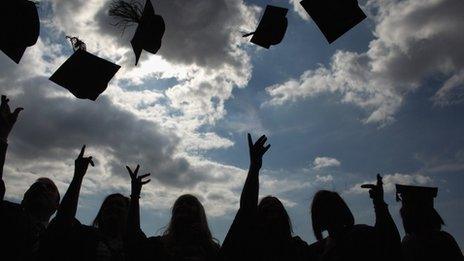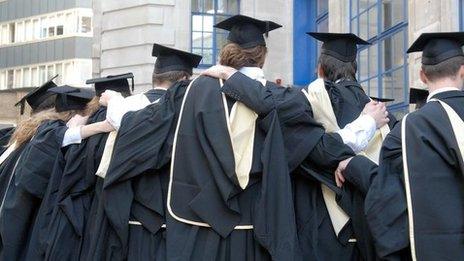University tuition-fee change savings 'uncertain'
- Published
.jpg)
Fees were trebled to £9,000 a year in 2012
The public cost of higher university fees and loans is "highly uncertain" and depends on how much future graduates will earn, a study says.
The Institute for Fiscal Studies (IFS) report says ministers will not know for decades whether their higher education funding shake-up will save money.
In 2012 tuition fees were trebled to a maximum of £9,000 a year and paid through upfront subsidised loans.
The government said the loans were not currently a pressure on the system.
Money lost
Graduates only repay when they earn more than £21,000 a year, and unpaid loans are cancelled after 30 years.
The IFS report looks at the group of English, full-time undergraduates who started university in 2012 - the first year of the new fees system.
It calculates 57p of every £1 the government loans to students will be recouped.
On average, each student will be lent just over £40,000 in today's money, the IFS estimates.
Public purse
On top of that, the government is paying £24,500 per student per year in teaching grants to universities and maintenance grants to students.
The IFS prediction that 43% of the money loaned will be lost is based on earnings rising in line with Office of Budget Responsibility (ORB) forecasts from December 2013.
If they grow by the more optimistic path forecast by the OBR in March 2012, the cost to the public purse would be nine percentage points less.
The figures also took into account what it cost the government to borrow the money it lent to students, the think tank said.
Taxpayer contribution
The IFS calculates taxpayer contributions to university tuition are now only 5% lower than they would have been under the pre-2012 system, when universities were given much bigger teaching grants from central government.
A rise in tuition fees of £500 a year would increase the taxpayer contribution under the new system of loans to that of the old one, it says.
And it estimates removing the cap on student numbers and adding an extra 60,000 students each year would cost the government an extra £1.7bn.
Report author Wenchao Jin said: "The public cost of the student loan system is highly uncertain.
"It depends on graduates' earnings and repayment behaviour many years into the future, which we - and the government - can only estimate.
"Our baseline estimates now suggest that the total government contribution per student has fallen slightly as a result of the government's reforms, but that even a small real increase in fees would wipe out these gains.
"Whether these reforms have reduced the taxpayer subsidy will remain unknown for many years to come."
More funding
A Department for Business, Innovation and Skills spokeswoman said: "As a result of our reforms, a greater proportion of students from disadvantaged backgrounds are going to university than ever before.
"We have protected those on lower incomes by increasing the repayment threshold to £21,000.
"Our universities are well funded for the long term and now receive around 25% more funding per student for teaching.
"These figures for repayments are estimates and based on a prediction of economic circumstances some 35 years in the future.
"They will continue to fluctuate and do not present an immediate pressure on the system."
Liam Byrne, the shadow minister for universities, science and skills, said the new system "could end up costing the taxpayer more than the one it replaced".
He added: "The only thing we're guaranteed from this Tory-led government's university funding system is uncertainty."
- Published10 April 2014

- Published24 March 2014

- Published22 March 2014
